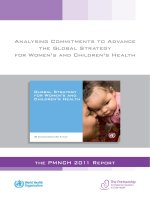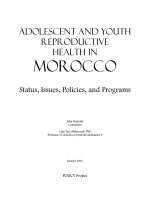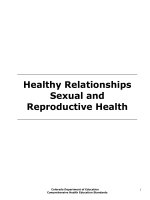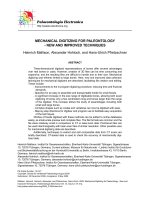engaging Men for Gender equality and improved Reproductive Health doc
Bạn đang xem bản rút gọn của tài liệu. Xem và tải ngay bản đầy đủ của tài liệu tại đây (532.32 KB, 6 trang )
Overview
The importance of constructive men’s engagement
(CME) in reproductive health (RH) has taken hold
around the world over the past decade. Skeptics are
being won over by the preponderance of evidence:
unless men are actively engaged in supporting
better health and well-being for families and the
empowerment of women, progress will remain
slow; women will remain vulnerable to reproduc-
tive health threats, including gender-based vio-
lence; and men themselves will remain trapped in
the confining space of traditional masculine norms.
These norms, including risk-taking, lack of health-
seeking behavior, and emotional distance from
women and children, harm men as well as women
and children.
These harmful masculine norms can be challenged
and changed. Numerous program examples from
around the world show that men can be successfully
engaged in gender-equitable decisionmaking—shar-
ing responsibility for contraception, supporting
safe childbirth, preventing violence, and protecting
themselves and their loved ones from HIV and other
sexually transmitted infections (STIs). These pro-
grams can have enormous payoffs for women, men,
and families, but they must reach a much larger
audience if they are to have an impact on gender
norms, which are societies’ expectations of how men
and women should behave. For this to occur, work
to promote constructive men’s engagement must
move to the policy level, where broader reforms can
be defined, implemented, and mandated.
Why Engage Men? A Brief History
A decade ago, “addressing gender” in the context of
reproductive health and family planning programs
was, by and large, synonymous with the empower-
ment of women. Women’s health activists, who
had fought to get women’s empowerment on the
development agenda, recognized the transformative
influence that changing gender norms could have
on health and human rights, and were concerned
that involving men would take resources and atten-
tion away from women. When the World Health
Organization (WHO) developed a gender training
initiative for policymakers and program manag-
ers, it focused exclusively on meeting the strategic
gender needs of women.
5
The competition for scarce resources notwith-
standing, more women’s health activists have now
joined with those promoting CME to acknowledge
that gender equality—a balance in the power and
Engaging Men for Gender Equality
and Improved Reproductive Health
The “One Man Can” campaign is Sonke Gender Justice Network’s flagship project
(photo courtesy of Sonke).
“Men, through their roles in the home, the community and at the national level, have the
potential to bring about change in attitudes, roles, relationships and access to resources and
decision-making which are critical for equality between women and men…. Men should
therefore be actively involved in developing and implementing legislation and policies to foster
gender equality, and in providing role models to promote gender equality in the family, the
workplace and in society at large.”
– Former UN Secretary General, Kofi Annan
1
privilege, responsibilities and resources that men and
women possess—is more likely to be achieved when
men see the advantages for themselves, their partners,
and children in more equitable relationships with
women and girls.
6
A New Direction
A landmark WHO 2007 report, Engaging Men and
Boys in Changing Gender-Based Inequity in Health,
7
helped move the field in a new direction. Taking stock
of a decade of program interventions involving men,
and the extent to which they had been evaluated, the
report identified interventions that had been successful
or promising in changing men’s attitudes and behaviors,
and improving health outcomes for men, women, and
children. The investigators found that gender-transfor-
mative approaches—which deliberately involve partici-
pants in reflecting upon, questioning, and changing
inequitable gender norms—were more effective than
other approaches in changing attitudes and behaviors.
However, the report concluded that, despite successful
outcomes, all reviewed studies were short-term or pilot
programs and none have been sustained.
One of the main conclusions of the 2007 report is
that while there is sound evidence that gender norms can
be changed, men must be included in order to achieve a
favorable shift in the power imbalances between men and
women and to arrive at more equitable and just societies.
Successful constructive men’s engagement would involve
creating a social movement for change through:
n
Long-term investment in reaching boys and
young men in their formative years;
n
Far more attention to scale-up and to bringing
about structural and policy changes necessary to
promote change on a large scale;
n
Policy initiatives in which gender equality is
established as a new social norm; and
n
Research that assesses the impact of legal and
policy changes on men’s behaviors and norms.
In fact, a broad consensus is now emerging in the
gender and development field that change in gen-
der norms at a societal level requires embedding the
constructive engagement of men into public policy,
through the passage and enforcement of laws, the fund-
ing of policy priorities, and through working with key
stakeholders and the women’s health and rights move-
ment to achieve common objectives.
Getting Started on Policy Change
A policy is a set of coherent decisions with a common
long-term purpose. A public policy has been described as
a set of laws, regulatory measures, course of action (or in-
action) and funding priorities chosen by public authori-
ties to address a problem or interrelated set of problems.
8
Engaging Men for Gender Equality and Improved Reproductive Health
2
1995: USAID’s internal Task Force on Gender recognized
that women’s ability to prevent unintended pregnancies,
have safe deliveries and healthy birth outcomes, and pro-
tect themselves from HIV and other STIs often depends on
the cooperation, if not the consent, of their male partners.
1996: USAID surveyed its cooperating agencies on the
extent to which men’s roles were considered in implement-
ing family planning (FP) and reproductive health (RH) pro-
grams. The survey revealed that nearly all programs were
tailored to reach women, and few engaged husbands,
fathers, and sexual partners.
2
1997: USAID launched the Interagency Gender Working
Group (IGWG) and convened a Subcommittee on Men
and Reproductive Health. Thirty-five international organiza-
tions met quarterly with USAID colleagues for a number of
years to debate, develop strategies, and share knowledge
on how to constructively involve men in reproductive and
maternal health programs for the benefit of women, chil-
dren, and men themselves.
1997-2003: The Men and RH Subcommittee developed
guidance for the field on gender-sensitive men’s involvement
in family planning, safe motherhood, HIV/AIDS programs,
fatherhood, and adolescent programming.
3
USAID coop-
erating agencies increasingly implemented programs that
aimed to foster behaviors in which power, privilege, and
responsibility were more equitably shared between men
and women.
2003: USAID and the Men and RH Subcommittee hosted
an international conference to share best practices, opera-
tions research, pilot programs, and alliances promoting
positive men’s engagement in RH.
2006: IGWG compiled a decade of research and
programmatic guidelines into an electronic brochure,
SysteMALEtizing Resources for Engaging Men in Sexual
and Reproductive Health. Constructive men’s engagement
(CME) was defined as the aim to involve men in reproduc-
tive health in three overlapping roles: as clients of RH
services; as supportive partners to women; and as agents
of change in the family and community.
4
USAID’S SUPPORT FOR CME
3
Policy changes are often a response to social needs as well
as to social justice and claims and concerns raised by experts
and advocacy groups. But there are many steps between iden-
tifying the need and achieving effective action (see Figure 1).
A “policy scan”—a review of existing policies, laws
and practices related to sexual and reproductive health and
rights—is often the appropriate starting point. Once the pol-
icy landscape is known, advocates can raise awareness of laws
aimed to promote better sexual and reproductive health that
are not enforced, as well as areas where new legislation needs
to be drafted. In April 2009, nearly 500 participants met in
Brazil at the Global Symposium on Engaging Men and Boys
to exchange lessons learned in their work and to set a strategic
agenda. The resulting Rio Declaration
9
urged the elimination
of any policies that are inherently gender-inequitable:
“Governments should repeal all discriminatory laws and
act on their existing national, international, and UN obli-
gations and commitments, prioritize and allocate resources
to gender transformative interventions, and develop poli-
cies, frameworks and concrete implementation plans that
advance this agenda [of engaging men and boys to achieve
gender equity].
The Rio Declaration, April 3, 2009
Promising Policy Initiatives
At the policy level, constructive engagement of men is still in its
infancy. Cambodia was among the first countries to examine
existing policies regarding men’s involvement in sexual and
reproductive health, starting in 2003. This effort, initiated by
civil society, led to the formulation of national guidelines for
constructively engaging men. The report of the policy scan
rightly observed that while national policies provide a vision
and framework for moving forward, they need to be imple-
mented and put into action through multi-sectoral programs
and operational policies—the regulations, resource allocation,
and systems that link laws and policies to programs.
10
Gov-
ernment buy-in is essential.
The four promising policy initiatives below illustrate com-
ponents of the policy process, particularly data gathering and
analysis, policy scans, alliance building, strategy development,
and action planning. Over time, these initiatives have the po-
tential to create transformative change in the laws and policies
that govern relationships between men and women.
Men and Gender Equality Policy Project (MGEPP) –
Providing the evidence base for national and global
accountability.
This project is a collaborative effort among or-
ganizations based in a number of developing countries as well as
in Norway. Its objective is to provide policymakers and program
planners with data and feasible strategies to achieve large-scale
change in men’s attitudes and behaviors relating to sexual and
reproductive health, gender-based violence, fatherhood, maternal
and child health, and men’s roles as caregivers.
11
Strategies will
be informed by the International Men and Gender Equal-
ity Survey (IMAGES), a stratified survey of randomly selected
households, carried out in 2009 in Brazil, India, Chile, Mexico,
Croatia and South Africa. Surveys will be carried out in 2010 in
Bangladesh, Cambodia, and Rwanda. Adapted in part from Nor-
way’s Gender Equality and Quality of Life Survey and the WHO
Multi-country Study on Violence against Women, IMAGES
surveys men and women (ages 18-59) about men’s attitudes
and behaviors on a wide range of issues. Preliminary findings
show that care giving and household tasks still remain strongly
divided by gender; some men would like to be more involved in
the care of their children but are hampered by lack of paternity
leave policies; and perpetration of violence is associated with
a childhood experience of violence, men’s belief in inequitable
gender norms, and men’s economic disempowerment, stress or
shame due to under- or unemployment. In addition to supplying
evidence of where policy change is needed, IMAGES will provide
an important baseline for measuring changes in social norms and
behaviors over time as policy changes are enacted.
Engaging Men for Gender Equality and Improved Reproductive Health
Figure 1. A Process for Advocating for Policy Change
Adapted from Health Policy Initiative’s Policy to Action Framework, 2009.
1. Gather Data and
Conduct Policy Scan
2. Engage
in Policy
Dialogue &
Build Alliances
3. Develop
Policy and
Strategy &
Cultivate
Champions
4. Develop Action
Plan & Mobilize
Resources
5. Implement
Action Plan
6. Monitor &
Evaluate Action
Plan and Policy
POLICY
CHANGE
MenEngage Alliance – Building networks to sup-
port evidence-based advocacy and action.
More
than 400 organizations in sub-Saharan Africa, Latin
America and the Caribbean, North America, Asia, and
Europe have formed this Alliance to further CME ef-
forts around the world.
12
In October 2009, the Alliance
sponsored a symposium in South Africa, “Strengthening
Capacity of Civil Society and Government to Work with
Men and Boys on Gender-Based Violence and HIV.”
The symposium brought together activists, policymak-
ers, service providers, and researchers working on gender,
HIV, health, development, and human rights to produce
clear country- and region-specific action plans
13
to facili-
tate policy dialogue and advocacy and promote imple-
mentation of new policies to address these issues.
Men as Partners (MAP) – Mobilizing leaders to
promote national dialogue and reform policies
and law.
In Tanzania, where this international program
has been active since 1996, a scan of key health policy
documents revealed that the government commitment to
men’s engagement was evident only in relation to its na-
tional HIV policies. However, this provided an opening
to advocate for greater men’s engagement in other health-
related policies.
14
MAP’s CHAMPION Project
15
is
mobilizing men to “redefine” what it means to be a man,
and take an active stance for gender equality. CHAM-
PION promotes a national dialogue about gender roles,
encouraging gender equitable beliefs and behaviors, and
strengthening national policies and laws with relevance
to gender. The CHAMPION workplace program is sup-
porting the development of employer policies that pro-
vide more comprehensive HIV and RH services to men.
CHAMPION also engages with district-level health
offices to make men’s HIV services more accessible and
of higher quality. At the national level, CHAMPION is
currently working with the National Ministry of Health
to include a new module on clinical HIV services for
men within the national HIV Voluntary Counseling and
Testing training curriculum and the National PMTCT
Services training curriculum.
The “Men- Let’s Be Accountable” campaign asks
men to do specific things to benefit society and pro-
mote gender equity. With high rates of HIV among
pregnant women, prevention of mother- to-child trans-
mission of HIV (PMTCT) is an important national
priority. Accompanying female partners to PMTCT
centers was prioritized as a critical and concrete stop
that men can take to support their partners and protect
offspring. Providers are trained to offer male-friendly
couple counseling and men are trained as facilitators for
family health. MAP is a key member of the Men En-
gage Alliance, and CHAMPION’s future policy agenda
will include advocating for national policies to engage
men in preventing gender-based violence.
Sonke Gender Justice Network – Implementing
actions to hold government accountable for poli-
cies to promote gender equity.
Established in South
Africa in 2006, Sonke Gender Justice now works across
Southern Africa on policy reform, especially related to
the intersection of HIV and gender-based violence. In
South Africa, Sonke is both challenging national poli-
cies that support traditional male gender norms and ad-
vocating for the enforcement of policies and strategies
that were developed in response to the harmful legacy
of apartheid.
16
Although the South African govern-
ment declared in 1994 that achieving gender equality
was a national goal, Sonke has drawn attention to the
government’s failure to achieve that objective, includ-
ing its ineffective efforts to reduce the highest reported
incidence of rape of any country.
17
Sonke Gender Justice undertook an extensive
analysis to review laws and policies related to homi-
cide, domestic and sexual violence, firearms, gangs and
organized crime, incarceration, juvenile justice, alcohol
and substance abuse, violence in the media, employ-
ment, HIV and health policy, including male circumci-
sion. The findings reveal that, despite the constitutional
commitment to gender equality, some policies perpetu-
ate traditional masculinities, while others, such as the
national HIV/AIDS strategic plan, acknowledge the
importance of gender but fail to offer any specific poli-
cy guidance. Sonke argues that policies must be aligned
with the government’s stated goals and commitments:
“Public policy is generally geared to limit, constrain or
punish men’s behavior. Much less often is policy framed
as providing an opportunity to change constructions of
masculinity in a positive way as part of a broader so-
cial project of building gender equity in society through
constructive engagement of men and boys.”
18
Sonke is now challenging the South African gov-
ernment to live up to international agreements such as
CEDAW and the Beijing Platform of Action, to pass
national gender legislation, and to provide clear budget-
ary allocations for enactment and enforcement of these
more progressive policies.
4
Engaging Men for Gender Equality and Improved Reproductive Health
5
Recommendations
20
To bring constructive men’s engagement to scale, societ-
ies must enact and enforce legislative and institutional
changes that eliminate harmful gender norms. Creating
lasting social change requires fostering alliances within
and outside of legislative bodies, holding governments
accountable for commitments to international agree-
ments and to constitutional law, and enacting new
gender transformative policies and legislation. Policy
and advocacy audiences are encouraged to:
Engage in dialogue from the beginning
Reach out to gatekeepers who may act as roadblocks
to change; Include sectors of the government outside
of health, including Ministries of Labor and Educa-
tion, to develop and implement a multi-sectoral CME
approach.
Build a sustainable social movement
Valuable partnerships can be created among civil
society, other social justice movements, and the private
sector, including industries that employ primarily men.
Speak with a unified voice and seek statements of sup-
port from leading organizations.
Ensure support of women’s rights organizations
Work collaboratively on policy positions and actions with
women’s groups to achieve common gender quality objec-
tives and to demonstrate that women support and welcome
these efforts.
Align with networks
International organizations promoting policy change
for gender equity and men’s accountability, such as the
MenEngage Alliance and the White Ribbon Cam-
paign,
21
offer guidance on developing action plans and
overcoming challenges. Alignment adds visibility and
credibility to local and national efforts.
Appeal to men as partners, fathers, and members of society
Drawing attention to men’s roles as responsible facilita-
tors rather than obstacles to improved health, highlights
the social benefits of constructive men’s engagement for
men as well as their families and communities.
Enlist cultural icons and authoritative agents of change
Capitalize on normative change that is already under-
way. Promote progressive role models by enlisting sup-
port from representatives of media and popular culture
as well as coaches, teachers, and religious leaders.
Engaging Men for Gender Equality and Improved Reproductive Health
Mali, a country with enormous health challenges, provides
a model of the policy reform process to constructively
engage men. Women in Mali are largely illiterate (83
percent), and have limited autonomy to make decisions,
including in regard to their own reproductive health. Only
six percent use a modern method of contraception, and
the birth rate remains among the highest in Africa, an aver-
age of six births per woman. But the policy environment
is shifting, as political and religious leaders have increas-
ingly voiced support for family planning and reproductive
health. Over the course of several years, multiple organi-
zations and stakeholders have come together on this effort,
drawing on each others’ expertise and skills to engage
men and improve reproductive health.
n
In 2003-4, the USAID mission brought in the IGWG to
provide gender training for its staff and partners, spark-
ing interest in the role of men in reproductive health in
Mali;
n
In 2005, the Mission’s Gender Strategy highlighted
CME to improve health;
n
In 2006, the Health Policy Initiative (HPI) conducted an
assessment, and a stakeholders group was formed to
support the development of national CME guidelines.
n
In 2007, with the Ministry of Health (MOH) on board
and the Cambodian CME policy as a model, an
advisory group drafted guidelines for engaging men in
RH. The IGWG training module on constructive male
engagement was used to train program implementers
from international and national civil society and faith-
based organizations as well as staff from the Ministries
of Health, Women, and Youth;
n
In 2008, the MOH approved the draft national CME
guidelines. The guidelines were a result of the years of
collaboration between the MOH and various partners,
including the National Technical Assistance Project
(ATN), Futures Group, HPI/Mali, IntraHealth, and pri-
vate consultants. A training of trainers was piloted with
a RH program implemented by Care International.
With the receptivity of the country’s leaders to improve
RH and the sustained interest of USAID Mission personnel
committed to gender equity, multi-sectoral support was built
for constructive men’s engagement. While implementation
and effectiveness of the National CME Guidelines must be
monitored, policy reform in Mali has the potential to offer
important lessons for future policy reform efforts.
19
“STEP BY STEP” TO DEVELOP AND SCALE UP CME POLICIES IN MALI
Use data effectively
Data on the social and economic costs of harmful male gender
norms can be powerful. Demonstrate to legislators that CME
leads to improved health outcomes and saves money. Document,
e.g. through IMAGES survey data, the health and social benefits
of more equitable relationships between men and women.
Measure accountability
Routinely monitor the implementation of policy changes,
and evaluate whether social norms and health outcomes are
changing over time. Maintain ongoing dialogue with policy-
makers.
Conclusion
Policy solutions need to embrace gender equity as a defining
principle; to ensure that laws, policies and programs apply to
all people, and will be implemented in such a way that the
unbalanced allocation of resources and power between men and
women, boys and girls, and between different social groups is
addressed. Policy work to support the constructive engagement
of men in reproductive health is only beginning in most coun-
tries, including many developed countries. With clear guidance
that CME advances gender equity, and with useful models
and policy guidelines to adapt, this work can be expected to
advance more quickly. A more equitable future is in sight.
Endnotes
1
Report of the UN Secretary General, e Role of Men and Boys in Achieving
Gender Equity, December, 2003, E/CN.6/2004/9.
2
N. Danforth and C. Green, Involving Men in Reproductive Health: A
Review of USAID-Funded Programs, USAID Poptech report no. 96-070050,
April, 1997.
3
IGWG, ree Case Studies: Involving Men to Address Gender Inequities
(Washington, DC: PRB for the IGWG, 2003); IGWG, Involving Men in
Sexual and Reproductive Health, A Training Guide (Washington, DC: PRB
for the IGWG, 2001); IGWG, Implementation Guide on Reaching Men to
Improve Reproductive and Sexual Health For All (a CD-ROM based on the
programmatic issues discussed at the International conference, Reaching
Men to Improve Reproductive Health for All, Dulles, Virginia (Baltimore,
MD: JHUCCP for the IGWG, September, 2003).
4
See www.igwg.org/Publications/Systemaletizing.aspx.
5
World Health Organization (WHO), Transforming Health Systems, Gender
and Rights in Reproductive Health (Geneva: WHO, 2001).
6
Evaluation of the WHO Training Initiative, “Transforming Health Sys-
tems, Gender and Rights in Reproductive Health” (Geneva: WHO, 2008).
7
WHO, Engaging Men and Boys in Changing Gender-Based Inequity in
Health: Evidence From Programme Interventions (Geneva: WHO, 2007).
8
R. Wolf (2000) cited in J. Redpath et al., Public Policy in South Africa.
9
See www.menengage.org/symposium2009_rio.asp.
10
M. Greene, N. Walston, A. Jorgensen, M.R. Sambath, and K. Hardee,
“From Adding to the Burden to Sharing the Load: Guidelines for Male In-
volvement in Reproductive Health in Cambodia,” Report for USAID, 2006.
11
See www.icrw.org/ppt/men-and-boys/men-and-gender-equality-policy-
project-gbarker.pdf.
12
See www.menengage.org.
13
See www.genderjustice.org/za/menengageafricasymposium.html.
14
A. Levack, “Addressing Male Engagement in Tranzanian Programs and
Policies: A Call to Action,” Draft, 12-02-08.
15
e Champion Project is a ve-year project of EngenderHealth/Tanzania,
funded by USAID, through PEPFAR.
16
Sonke Gender Justice Network, “Men for Change, Health for All, A
Policy Discussion Paper on Men, Health and Gender Equity” (Johannes-
burg, South Africa: 2008).
17
Sonke Gender Justice Network, “Enlisting Men for Women’s Equality,” 2008.
18
J. Redpath, R. Morrell, R. Jewkes, and D. Peacock, “Masculinities and
Public Policy in South Africa: Changing Masculinities and Working Toward
Gender Equity,” by Sonke Gender Justice and the Medical Research Coun-
cil of South Africa, 2008.
19
See “Mission Possible in Mali anks to Partnership Initiative,” accessed
online Dec. 1, 2009 at www.igwg.org/Articles/missionpossible.aspx; and
E. Doggett and B. Herstad, Men Matter: Scaling Up Approaches to Promote
Constructive Men’s Engagement in Reproductive Health and Gender Equity
(Washington, DC: Health Policy Initiative, Task Order 1, Futures Group
International., 2008).
20
ese recommendations draw from the work of the organizations proled
in this brief, and from ICRW and Instituto Promundo. See www.icrw.org/
docs/Engaging_Men_and_Boys_to_Achieve_Gender_Equality.pdf
21
e Canada-based White Ribbon Campaign works in 60 countries to end
men’s violence against women. See www.whiteribbon.ca.
Acknowledgments
This policy brief was written by Karin Ringheim and Char-
lotte Feldman-Jacobs of Population Reference Bureau (PRB),
with appreciation for the contributions of Michal Avni and
Patty Alleman, USAID’s Office of Population and Reproduc-
tive Health; Jay Gribble, PRB; Gary Barker, ICRW; Andrew
Levack, EngenderHealth; and Dean Peacock, Sonke Gender
Justice. Funding was provided by USAID, under the BRIDGE
Project (Cooperative Agreement GPO-A-00-03-00004-00).
©2009 Population Reference Bureau. All rights reserved.
For More Information
This policy brief is on the IGWG website: www.igwg.org.
To obtain printed copies of this policy brief, contact:
Population Reference Bureau
1875 Connecticut Ave., NW, Suite 520
Washington, DC 20009 USA
E-mail:
Web: www.prb.org
PRINTED WITH
SOY INK
TM









